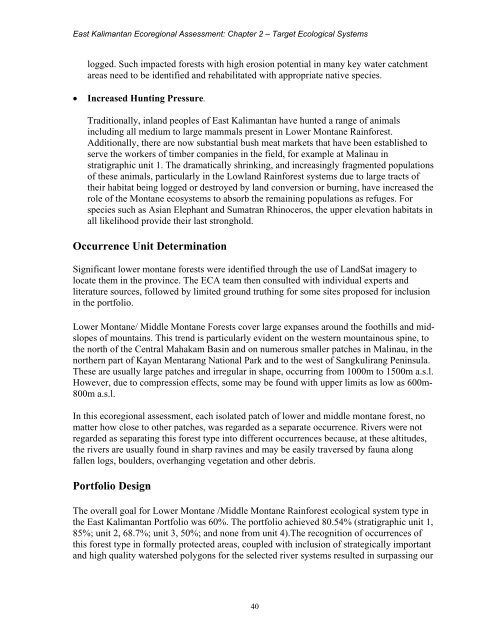Ecoregional Assessment of Biological Diversity in East Kalimantan
Ecoregional Assessment of Biological Diversity in East Kalimantan
Ecoregional Assessment of Biological Diversity in East Kalimantan
You also want an ePaper? Increase the reach of your titles
YUMPU automatically turns print PDFs into web optimized ePapers that Google loves.
<strong>East</strong> <strong>Kalimantan</strong> <strong>Ecoregional</strong> <strong>Assessment</strong>: Chapter 2 – Target Ecological Systems<br />
logged. Such impacted forests with high erosion potential <strong>in</strong> many key water catchment<br />
areas need to be identified and rehabilitated with appropriate native species.<br />
• Increased Hunt<strong>in</strong>g Pressure.<br />
Traditionally, <strong>in</strong>land peoples <strong>of</strong> <strong>East</strong> <strong>Kalimantan</strong> have hunted a range <strong>of</strong> animals<br />
<strong>in</strong>clud<strong>in</strong>g all medium to large mammals present <strong>in</strong> Lower Montane Ra<strong>in</strong>forest.<br />
Additionally, there are now substantial bush meat markets that have been established to<br />
serve the workers <strong>of</strong> timber companies <strong>in</strong> the field, for example at Mal<strong>in</strong>au <strong>in</strong><br />
stratigraphic unit 1. The dramatically shr<strong>in</strong>k<strong>in</strong>g, and <strong>in</strong>creas<strong>in</strong>gly fragmented populations<br />
<strong>of</strong> these animals, particularly <strong>in</strong> the Lowland Ra<strong>in</strong>forest systems due to large tracts <strong>of</strong><br />
their habitat be<strong>in</strong>g logged or destroyed by land conversion or burn<strong>in</strong>g, have <strong>in</strong>creased the<br />
role <strong>of</strong> the Montane ecosystems to absorb the rema<strong>in</strong><strong>in</strong>g populations as refuges. For<br />
species such as Asian Elephant and Sumatran Rh<strong>in</strong>oceros, the upper elevation habitats <strong>in</strong><br />
all likelihood provide their last stronghold.<br />
Occurrence Unit Determ<strong>in</strong>ation<br />
Significant lower montane forests were identified through the use <strong>of</strong> LandSat imagery to<br />
locate them <strong>in</strong> the prov<strong>in</strong>ce. The ECA team then consulted with <strong>in</strong>dividual experts and<br />
literature sources, followed by limited ground truth<strong>in</strong>g for some sites proposed for <strong>in</strong>clusion<br />
<strong>in</strong> the portfolio.<br />
Lower Montane/ Middle Montane Forests cover large expanses around the foothills and midslopes<br />
<strong>of</strong> mounta<strong>in</strong>s. This trend is particularly evident on the western mounta<strong>in</strong>ous sp<strong>in</strong>e, to<br />
the north <strong>of</strong> the Central Mahakam Bas<strong>in</strong> and on numerous smaller patches <strong>in</strong> Mal<strong>in</strong>au, <strong>in</strong> the<br />
northern part <strong>of</strong> Kayan Mentarang National Park and to the west <strong>of</strong> Sangkulirang Pen<strong>in</strong>sula.<br />
These are usually large patches and irregular <strong>in</strong> shape, occurr<strong>in</strong>g from 1000m to 1500m a.s.l.<br />
However, due to compression effects, some may be found with upper limits as low as 600m-<br />
800m a.s.l.<br />
In this ecoregional assessment, each isolated patch <strong>of</strong> lower and middle montane forest, no<br />
matter how close to other patches, was regarded as a separate occurrence. Rivers were not<br />
regarded as separat<strong>in</strong>g this forest type <strong>in</strong>to different occurrences because, at these altitudes,<br />
the rivers are usually found <strong>in</strong> sharp rav<strong>in</strong>es and may be easily traversed by fauna along<br />
fallen logs, boulders, overhang<strong>in</strong>g vegetation and other debris.<br />
Portfolio Design<br />
The overall goal for Lower Montane /Middle Montane Ra<strong>in</strong>forest ecological system type <strong>in</strong><br />
the <strong>East</strong> <strong>Kalimantan</strong> Portfolio was 60%. The portfolio achieved 80.54% (stratigraphic unit 1,<br />
85%; unit 2, 68.7%; unit 3, 50%; and none from unit 4).The recognition <strong>of</strong> occurrences <strong>of</strong><br />
this forest type <strong>in</strong> formally protected areas, coupled with <strong>in</strong>clusion <strong>of</strong> strategically important<br />
and high quality watershed polygons for the selected river systems resulted <strong>in</strong> surpass<strong>in</strong>g our<br />
40

















